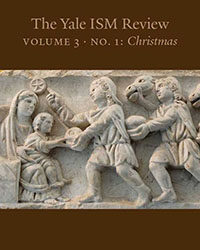Susan K. Roll
Scanning recent news sources, anyone preparing for the upcoming celebration of Christmas might wonder how exactly we can manage to celebrate wholeheartedly in a global climate of terrorist attacks, massive migrations of traumatized war victims and economic refugees, and generalized fear for the future. Commentators, syndicated columnists and political cartoonists in recent times have highlighted the sharp dichotomy between what, for Christians, is above all a season of light in the darkness and a growing sense of apprehension that the darkness is in fact gaining on us.
Admittedly other periods of history have known serious gaps between the hoped-for “comfort and joy” of Christmas and prevailing conditions. Yet one only need recall depictions of soldiers in the trenches of World War I, managing to mark Christmas by temporarily replacing hostilities with fraternization, to appreciate the resilience of Christians determined to celebrate Christmas. Their act was extraordinary, but the impulse behind it is not unique. In wartime, following natural disasters, or in times of crisis, families pull together a makeshift Christmas with fewer places at the dinner table, and celebrate as best they can—often “for the sake of the children.”
In the mid-fourth century, a huddle of Christians in North Africa faced an even more immediate threat: that of targeted persecution, torture and execution by their own government, for the crime of being Christian (more specifically, the wrong type of Christian). The earliest Christmas sermon we possess was preached, not in times of peace and safety, but in a fearful situation.
The Bishop’s Sermon on Christmas
In 1922, the Benedictine monk André Wilmart published a critical edition and commentary on a homily attributed to the mid-fourth-century Bishop Optatus of Milevis in Numidia, North Africa.[1] The manuscript exists in two editions, and while the version preserved in a homily collection at Fleury-sur-Loire, dating from the first half of the eighth century, carries the attribution to Optatus of Milevis,[2] a Carolingian-era copy preserved in the old ducal library at Wolfenbuttel does not.[3] The only other extant manuscript authored by Optatus was a historical account and rebuttal of the Donatists and specifically of Parmenianus, successor to Donatus as Bishop of Carthage, dated 364–375 for the first six books. A seventh was written a decade later. Wilmart’s argument for Optatus’s authorship of this sermon rests not only upon the attribution in the Fleury manuscript, but upon on the occurrence of a dozen similar expressions, some stylistic markers, a few identical mistakes in the Latin, and the overall energetic and simple (if a bit long-winded) approach, also present in Optatus’s anti-Donatist work.
This sermon represents the earliest liturgical evidence for a feast of the Nativity of the Lord on December 25, and may constitute the earliest credible textual witness to a Nativity feast in the West, aside from possibly spurious additions to the text of the Chronograph of Philocalus of 354. These additions were thought to constitute the earliest notation of a Nativity feast on that date in a Western calendar, using source material dated by many twentieth-century scholars from the year 336. This alone makes this sermon text significant for tracing the historical origins of the Nativity feast: it may be the earliest reliable extant witness.
What makes this particular sermon interesting for our purposes, however, was its real subject: not the Nativity account in the second chapter of Luke, nor any of the associated Christmas pericopes apart from the coming of the Magi. For Christmas, Optatus takes the massacre of the Holy Innocents, Matthew 2:16–18, as his primary text.[4] That scripture text, plus some specific references in the sermon itself, indicate that this sermon was most likely preached in the years 361–363 during the persecutions of Christians under the emperor Julian, traditionally known as “Julian the Apostate.” Officially, Christians in the then-overstretched and increasingly fragmented Roman Empire had enjoyed civil protection from persecution since Constantine’s Edict of Milan in 313, and in fact the Christian religion was in the midst of a massive surge in popularity. But Julian attributed the cause of the incipient breakdown of the grandeur and strength of Rome to a failure to honor and appease the ancient gods of Rome. In fact, already the first generation of Christians had been persecuted out of fear that tolerating a sub-group of residents who refused to sacrifice to the gods would result in calamity for the population as a whole when the gods took their revenge. Julian seems to have been convinced that nothing short of bringing back that old-time religion would stabilize the Empire and put it to rights with the heavenly powers.
Julian, however, did not persecute all Christians. His animus was against Nicene Christians—those who taught the pre-existence of Christ in a Trinitarian Godhead. In North Africa, which in matters of both church and state lay close to Rome, this meant expanding the already yawning gap between Nicene and Donatist Christians, a chasm that had resulted from the contested election of Donatus as Bishop of Carthage and the unseating of Caecilian. Donatists were, in many regions, the predominant Christian faction and considered themselves the pure remnant that had remained faithful during the last widespread persecutions under Diocletian in the first decade of the fourth century. They thought themselves the heirs of the early martyrs, and they fought hard to extend their influence, even through violent bands of roving gangs known as Circumcellions who terrorized the local populations.
Julian’s strategy was to split the Christians even further by favoring the Donatists, releasing some of their adherents from prison and revoking some of the restrictions imposed on them by the emperors Constantine and Constantius some years before. This disconcerting reversal of their preferred identity as the self-righteous martyr-elite did not sit at all well with them.
So Optatus’s frightened community in Milevis was under intense threat from two sides. And on the feast of the Nativity he attempted, through his preaching, to support and strengthen his people by placing the events that terrified them into the context of their faith.
The brief introductory paragraph on the mystery of Christ’s Nativity is followed by an extensive section on the story of “insane” Herod’s murderous persecution of the innocent children: If “secular powers” (a clear reference to the Romans) hate us, they first hated the one who is the Way, the Truth, and the Life. From the beginning of time innocence has suffered for the sake of truth, and the just ones will surely be saved. In the same way the Church, once persecuted, will enter into glory, and this is the hope of all Christians. Like the Magi, Christians present their gifts to God: the gold of their steadfast faith, the frankincense of their holiness of life and charity, and the myrrh of their suffering. Our faith is the gold tried in the fire. Let us hope therefore in the Lord, and we will be liberated from the devil and escorted by the angels.
Optatus, a local bishop caught in a firestorm of terror in a newly aggressive anti-Christian climate in Roman Africa, brought his own distinguished, though not brilliant, oratorical and theological skills to bear on the desperate pastoral needs of his people. He could not promise them physical safety, but in a carefully worked-out exhortation to courage, he set their fear of sudden attack into a solid scriptural framework and promised them peace, if only in the life to come.
A Stubborn Hope
So what of us? Preaching that all will be well in the next life will most likely not find ready acceptance among many contemporary Christians, who are only too likely to dismiss such ideas as “pie in the sky.” Indeed, popular culture fosters a certain degree of cynicism as a realistic attitude fully justified by the facts. And, to make matters worse, not only the news but also our entertainment is saturated with dread: We’ve seen all too many crime shows and apocalyptic movies that vividly illustrate the many things we fear. Hope does not come easily to us. Yet the Christmas we have, despite the pockmarks of cheap glitz, commercial exploitation, and plain greed, does embody a certain hope. It makes promises we cannot keep yet cannot abandon: promises of peace on earth in spite of organized terror, and of good will to all persons even as the social and economic gaps grow wider.
Christians drape lights on the trees, bake the cookies, attend the children’s pageants and flock to Midnight Mass even when we might not have thought of church all year. Our hopes, perhaps our hope against hope, lie under the surface of our seasonal customs and pervade our dogged resolution to honor the mysteries we cannot explain. We do not let the bullies win—be they fourth century Circumcellions or twenty-first century terrorists. And we celebrate Christmas with the best we have at hand.

Susan K. Roll is Associate Professor in the Faculty of Theology at Saint Paul University in Ottawa, Canada. Her specializations are in liturgy, sacraments and feminist theology, particularly the liturgical year, sacraments of initiation, and women in ministry. She holds a PhD degree from the Catholic University of Leuven, Belgium, with top honors, and has taught previously at Christ the King Seminary, Saint Michael’s College in Vermont and at Notre Dame University. She is the author of Toward the Origins of Christmas (Kampen: Kok-Pharos, 1995), several edited volumes on women and spirituality, and numerous articles and papers. www.ustpaul.ca/index.php?mod=employee&id=9
FOOTNOTES
[1] André Wilmart, « Un Sermon de saint Optat pour la fête de Noël, » Revue de sciences religieuses 2 (1922) : 271–302
[2] Wilmart specifies this as Manuscript nr. 131 in the municipal library of Orléans, pp 78–87.
[3] MS. 4096, folio 8 verso to 12 recto. This had been published in a 1918 edition of sermons of Saint Augustine by D. Morin.
[4] The Feast of the Holy Innocents dates only from the sixth century.
____
This material is licensed under a Creative Commons Attribution 4.0 License.
Recommended Citation: Roll, Susan K. (2016) “Christmas in Fear, or Looking over One’s Shoulder at the Creche,” The Yale ISM Review: Vol. 3: No. 1, Article 5. Available at https://ismreview.yale.edu
PDF: Christmas in Fear, or Looking over One’s Shoulder at the Crèche
